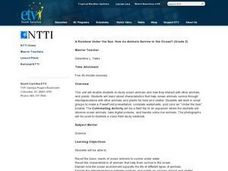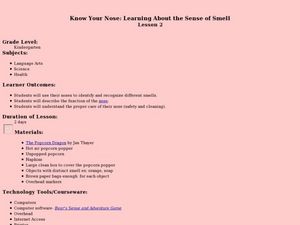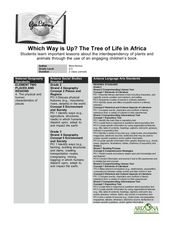Curated OER
Measuring With Graduated Cylinders
Students explore measuring with a graduated cylinder. In this measurement lesson, students observe liquids in a beaker. Students predict the volume of liquid in the beaker and then transfer the liquid to a graduated cylinder. Students...
Curated OER
Polar Bears
First graders explain what keeps Polar Bears warm in the Arctic by experiencing a layer of blubber to protect them. They read Little Polar Bear by Hans de Beer.
Curated OER
Recombinant DNA to Protect Crops
High schoolers read an article about manipulation of plant DNA. After reading the short article, they work in small groups to respond to the provided discussion questions and explain their answer to the class.
Curated OER
Earth & Beyond: Dryland Salinisation
For this earth and beyond worksheet, students read information about dryland salinsation, a serious problem facing Western Australia, and then answer 14 questions about the topic.
Curated OER
President's Place
Third graders read and research the features of the White House.In this President's Place lesson, 3rd graders read an article determine the main idea. Students understand how to footnote an article.
Curated OER
Seasons
Third graders draw a picture. In this seasons instructional activity, 3rd graders name the seasons of the year, discuss what happens during each season, read a poem for each season and draw a picture for each season.
Curated OER
From Seed to Apple
Young scholars identify the stages of apple growth. In this agricultural lesson, students read the story I Am Apple and sing the song "Round the Apple Tree." Young scholars place pictures of the stages of an apple into the correct order....
Curated OER
Weather Awareness
Second graders investigate weather. In this weather lesson, 2nd graders discover how to read a temperature gauge, keep track of the weather, and find out how the weather affects their day. They work individually and in partners to make...
Curated OER
Do You Have the Key?
Students practice using a dichotomous key. In this classification lesson, students read an article about scientific exploration and identification of new species. They use a dichotomous key to identify objects and create their own key.
Curated OER
Introductory Microbiology
Students view a Reading Rainbow video on germs and discuss microbial diseases. They grow cultures of Staphylococcus aureus and then estimate and graph the count for their own bodies and those of the class.
Curated OER
A Rainbow Under the Sea: How do Animals Survive in the Ocean?
Second graders read books, watch videos, complete worksheets and participate in class discussions about ocean animals. They, in groups, design PowerPoint presentations on selected marine animals.
Curated OER
Finger Painting and Feather Painting with Nature
Students explore finger painting and painting with feathers and recreate the look of objects in nature. They read the book, 'It Looked Like Spilt Milk,' create a shaving cream print, paint with feathers, and construct a mirror image on...
Curated OER
Wheat: From Field to Oven
How does wheat go from the seed to the table? While focusing on main ideas and supporting statements, class members read an excerpt about wheat production and complete a worksheet. The end goal is a display that shows the different...
Alabama Learning Exchange
The Very Hungry Class
Students listen to a read aloud of Eric Carle's, The Very Hungry Caterpillar, as an introduction to their study of the metamorphosis of a butterfly. They participate in a number of cross-curricular activities in this unit of lessons.
Curated OER
Weed Management Conflict
Students read and discuss conflict resolution scenario relating to weed management, role play members of different interest groups, prepare presentations and present to City Commissioners, and choose best land-use option.
Curated OER
Coral Reef: Water Cycle Center
In this coral reef water cycle worksheet, students read 4 sections of a table the include sentences about the water cycle. They cut out the sentences and paste them on a poster that sequences the steps of the water cycle. They draw a...
Curated OER
Compare and Contrast
In this compare/contrast worksheet, students look at pictures of a chair and a cat and read about they are similar and different. Next, students fill in a graphic organizer about how these 2 things are alike and different.
Curated OER
Know Your Nose: Learning About the Sense of Smell
Students explore their senses of smell. In this sense of smell lesson, students read The Popcorn Dragon and research the sense of smell on a designated website. Students identify scents and play an Internet game based on the sense of smell.
Curated OER
Our Treasured Trees
Students discuss natural resources and renewable resources with trees being considered renewable resources which need special attention. In this Earth science lesson, students write a list of reasons for why it would be good to stop...
Curated OER
The Fastest Pig in the West in the Classroom: Rice in China
Young scholars explore agriculture by reading a children's book in class. In this Chinese culture lesson, students read a chapter from the book The Fastest Pig in the West and identify the importance of rice in China's economy and...
Curated OER
Which Way is Up? The Tree of Life in Africa
Learners read a book titled This is the Tree about a baobab tree and draw a picture and label the tree. In this tree lesson plan, students also write a paragraph explaining why they drew that tree.
Curated OER
Out Of Control
Fifth graders study wildfires in the United States. In this wildfire lesson students read an article, make calculations and answer questions.
Curated OER
Butterflies A-Flutter
In this butterfly worksheet, students read about butterflies, then complete a graphic organizer, drawing pictures of 2 different butterflies, using a table of "stay-safe" butterfly tricks to help complete the chart.
Curated OER
Drought, nomads and the price of peanuts
Learners read two short text items, which describe different approaches to agriculture. They describe the likely advantages and disadvantages of each approach for farmers, commercial peanut buyers, the government, nomadic herdsman and...























